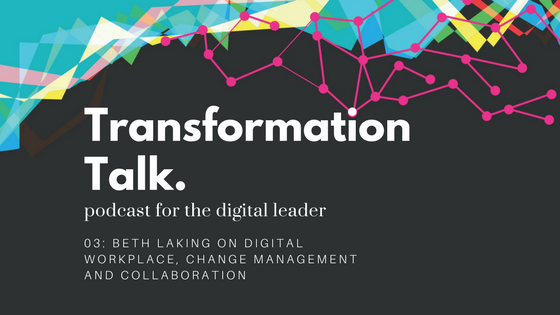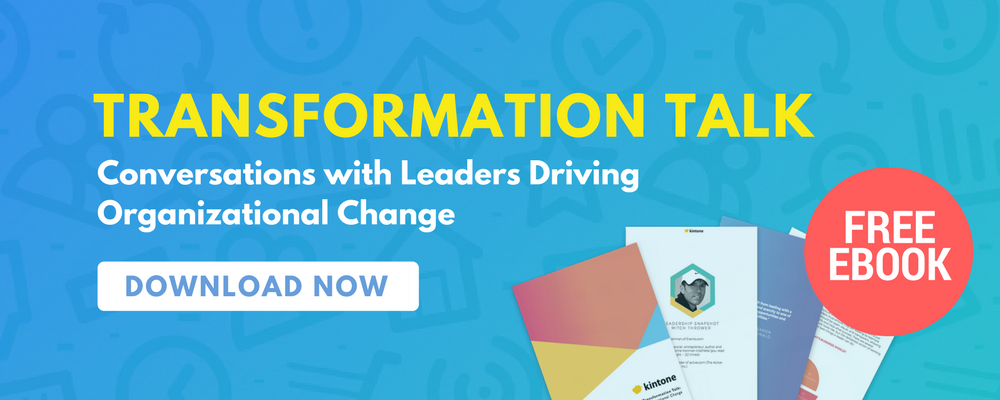This week we're speaking with Beth Laking, an expert on the digital workplace, including change management and collaboration.

Beth works with companies across multiple industries to help their executives build and implement transformation strategies. She's improving employee and customer engagement in her clients' businesses, while also improving productivity and sales.
Beth has worked in the change management space for over 20 years, and held leadership positions at CSC and Hewlett-Packard before branching into consulting. Her dynamic and enthusiastic approach has branded her visionary and creative, and she's sought after for her talents in building client relationships. Today she combines her wealth of experience with new technology, boldly leading businesses into the future.
Digital transformation feels like a modern concept, but you've been doing variations on it for over 20 years. How have these concepts have changed in that time, and how have they stayed the same?
Change management has really been here forever. Henry Ford implemented it in his first factory: he had to go through process workflow and training, communications, marketing, connecting with his staff. It is a part of our life because it's important to progressing and evolving. But people don’t want to hear “change management” as a term. It’s kind of like Fight Club: the first rule of change management is, “Don’t talk about change management.”
I think the reason that it feels more modern is because people have had pains of not incorporating change management in the past, and it hasn't been successful, and they're wondering why. The appetite for it is far greater now, because of the historic pains that people have had.
What’s the first thing you ask a new client?
The first thing you ask is "What's your goal?" Sometimes they don't know. Sometimes they're thinking, "Well, I hear so-and-so is really hot, so how do we do that?" But you always have to take it back to a business use case.
Understanding a business use case and going through the workflow allows you to understand the people involved and the successes they've felt. Dead zones they have. Duplicative activities. The next piece is going more in-depth, and it usually raises a lot of opportunity for success. But it also addresses the things that should stay the same.
ALSO READ: Manage Stuff, Lead People & Other Practical Advice For Stimulating Company Change & Innovation
If you had to pick one element of a business that's most crucial in enabling change, what would that be?
Agility. Change is ongoing. I look at digital transformation as business strategy, so it needs to become an inherent part of what we do.
You can't outline a static digital transformation strategy. It doesn't work. You need to anticipate that new information is going to come in, that there's integration issues, that there's cultural barriers, there's policy conflicts. There are political things going on. You have to be agile, and change as it goes.
What do you say to a client whose employees are resistant to change?
There's a personal reason, often, for resistance to change. The first thing that someone reflects on is, “How does it impact me? What's in it for me?” Resistance can be a fear. It can be a lack of trust. It can be a history of bad experiences. Usually there's an underlying issue to it.
You can reassure them by showing the perspective that change could be for the greater good. Also, they might learn new skills and reapply some of their knowledge to the evolution that’s taking place. But resistance also can come from not being heard. So if you're just doing it to them, then there might be resistance, because you're not even listening to how it's going to happen.
What’s the biggest hurdle you’ve had to overcome in companies you’ve worked with?
When companies are in flux, from a digital transformation, or from technology being launched, it often breeds fear. Where people might contribute, they tend to go on what they consider the safer side. So how do you create the ease in the midst of change in order to do that?
As a consultant, you're considered an objective party, so what they may not say to their leadership, they may say to me. And it's hard. It's not necessarily natural. People come with hesitancies. They don't know if they're overstepping bounds, and it comes from both leadership and staff.
How do you push forward new initiatives in a company, and at the same time ensure there is limited disruption to service?
You can't come in and just hand it over and walk away. There has to be some transition point there in which you're really mapping business processes. What's really critical, that's often forgotten, is what is the incentive to make this transition in the business? It may be personal: "This is going to save me so much time." Very rarely are you involving HR to write this into your job description, but writing it down creates an accountability to the process. Also, if it changes anything for your customers, you need to keep them apprised of what changes they can anticipate, as well.
What do you think the business of the future looks like in 10 or 20 years?
I think digital transformation will become a natural business strategy that will be a part of everyday. Realistically, you’re never done. So in 10 or 15 years you will have a leader who’s in charge of your digital workplace. And that leader is going to have an understanding of your culture, your business, and the technology that supports it.
The other part of the evolution is that we will bring our whole selves to work. We are not bringing a professional self and then a casual self; I’m going to stand as one. And sharing some of my history, some of what interests me, all of those things will help me operate better. We will have deeper relationships, but also more productive relationships because we’ve brought our personal side.
To expand on that personal piece: part of what we’re seeing is a need for not only mentorship, but sponsorship. The sponsorship of having someone who supports you in your endeavors, and promotes you. We were so politically correct for so long that we actually lost management skills. And now, blunt talk is allowed. But we need to find that balance point between quiet and blunt. We need to both have conversations and deal with each other professionally.
RELATED: Want to Improve Your Company? Encourage Honest Disagreement
I went hiking recently in North Carolina. One of the things that came to me while I was in the woods is this incredible ecosystem. And that you need all of those plants to hold the land, and how each of them performs for each other. So even your high growth protects them, but as the leaves fall away and that tree falls, it creates sun and growth for another. But not all of them are going to grow to be high growth, right? You need the rotting wood to support them and give nutrients. You need rocks to hold steady. You need ferns. You need flowers. You need animals. All of these things. I transfer that to a company, and you have an ecosystem of people there, and how they interrelate.
About the Author
Nicole is Director of Marketing at Kintone, with 10+ years experience in content strategy, campaign management, lead acquisition and building positive work cultures of empowered, purpose-driven team members. She spent seven years as a journalist, previously serving as a CBS San Francisco digital producer, NPR contributor, Patagon Journal deputy editor and reporter for several publications, including the Chicago Tribune. She's passionate about the tech for good space, social entrepreneurship and women leadership. On the weekends, you’ll likely find her putting her Master Gardener skills to use in at community gardens in Oakland.











